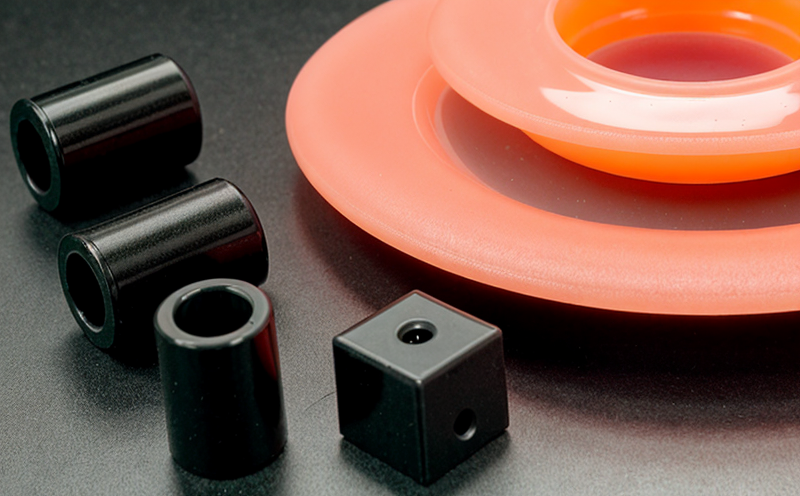ISO 175 Chemical Resistance Testing of Plastic Sports Gear
The ISO 175 chemical resistance testing method is a critical tool in ensuring the durability and longevity of plastic sports gear. This standard assesses how different chemicals interact with polymeric materials, helping manufacturers identify potential weaknesses or areas for improvement before products reach market. The test involves immersing samples in various solvents under controlled conditions to observe any changes in physical properties such as mass loss, deformation, and color change.
Quality managers rely on this testing to ensure compliance with industry standards, while R&D engineers use it to innovate new materials that can withstand harsh chemical environments. Compliance officers benefit from the insights gained through ISO 175 tests, ensuring their products meet regulatory requirements. For procurement teams, understanding ISO 175 results aids in sourcing reliable suppliers who adhere to stringent quality control measures.
In the context of sports and leisure plastics testing, this method is particularly important due to the diverse range of chemicals used in cleaning and maintenance routines across various sporting activities. From golf equipment to athletic footwear, ensuring these materials remain intact when exposed to solvents ensures performance consistency throughout their lifecycle.
Understanding the mechanics behind ISO 175 involves several key steps: selecting appropriate solvents based on expected usage scenarios; preparing samples according to specified dimensions and weight limits; placing them into containers filled with the chosen solvent at defined temperatures and times; then analyzing post-test conditions against initial states. By following these precise protocols, laboratories can provide accurate data that helps stakeholders make informed decisions regarding material selection and product design.
The importance of ISO 175 chemical resistance testing cannot be overstated for any manufacturer involved in producing plastic sports gear. It serves as a vital quality assurance measure ensuring customer satisfaction by delivering durable products capable of withstanding rigorous cleaning protocols without compromising on performance or integrity. Furthermore, compliance with this standard demonstrates a commitment to environmental responsibility, reducing waste associated with premature degradation.
Ultimately, ISO 175 chemical resistance testing is an indispensable process for maintaining high standards within the sports and leisure plastics industry. Its implementation allows manufacturers to innovate confidently knowing they are adhering to rigorous international standards that promote both quality assurance and sustainability practices.
Why It Matters
The significance of ISO 175 chemical resistance testing extends beyond mere compliance; it plays a crucial role in enhancing the overall performance and reliability of plastic sports gear. By subjecting materials to controlled exposure to various solvents, manufacturers can identify potential issues early on, allowing for timely adjustments or improvements before products reach consumers.
One major advantage is improved durability. Through repeated testing under realistic conditions, developers gain valuable insights into how different chemicals interact with their chosen polymers. Armed with this knowledge, they can fine-tune formulations to create stronger bonds between components, reducing the risk of premature failure during use or storage.
Another key benefit lies in enhanced safety for end-users. Ensuring that plastics remain stable when exposed to common cleaning agents prevents accidental damage caused by reactive materials. This not only protects user equipment but also fosters trust among customers who know they are purchasing safe, long-lasting products.
The importance of ISO 175 chemical resistance testing cannot be overstated for any manufacturer involved in producing plastic sports gear. It serves as a vital quality assurance measure ensuring customer satisfaction by delivering durable products capable of withstanding rigorous cleaning protocols without compromising on performance or integrity.
Scope and Methodology
The ISO 175 chemical resistance test is designed to evaluate the behavior of plastic materials when exposed to various solvents. The primary goal is to determine whether there will be any adverse effects on the physical properties, including mass loss, color change, or deformation. This information is essential for understanding how well a particular polymer withstands exposure to specific chemicals.
During the test, samples are prepared according to specified dimensions and weight limits before being placed into containers filled with selected solvents at defined temperatures and durations. After immersion, they undergo meticulous examination using advanced analytical techniques like Fourier Transform Infrared Spectroscopy (FTIR) or Differential Scanning Calorimetry (DSC). These methods help quantify changes in molecular structure and thermal stability resulting from solvent contact.
For more precise evaluation, additional tests may include tensile strength measurements or impact resistance assessments. Such comprehensive analysis provides a holistic view of the material's resilience against chemical attack, enabling manufacturers to select optimal grades for specific applications.
Industry Applications
| Application Area | Description |
|---|---|
| Golf Equipment | Testing ensures that club grips and shafts retain their integrity when exposed to cleaning agents used by golfers. |
| Athletic Footwear | Evaluates shoe soles made from polymers designed to maintain flexibility even after prolonged exposure to solvents during cleaning processes. |
| Cycling Helmets | Ensures that helmet liners composed of specific plastics do not degrade over time, maintaining protection against impacts. |
| Skis & Snowboards | Guarantees the stability and performance of base layers which are often subjected to harsh chemical treatments for waterproofing.|
| Swimming Gear | Verifies that swimsuits made from synthetic fabrics continue to provide comfort and fit after repeated exposure to chlorine bleach solutions used in pools. |
| Camping Equipment | Evaluates tents, sleeping bags, and other outdoor gear constructed from polymers that must remain functional despite frequent contact with water-based solvents like detergents. |
| Outdoor Furniture | Assures that furniture pieces fabricated using plastic composites can withstand prolonged exposure to environmental factors including UV radiation and various cleaning products. |





